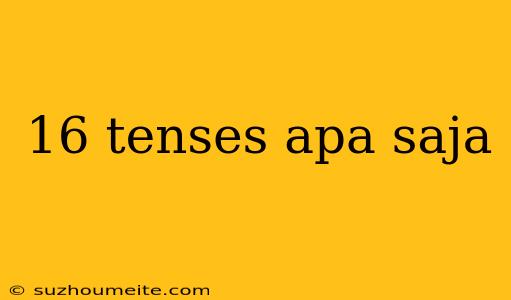Tenses in English: A Comprehensive Guide
In English grammar, tenses play a vital role in communicating time and aspect in sentences. There are 16 tenses in total, each with its own unique function and usage. In this article, we will explore the 16 tenses in English, their definitions, and examples.
Simple Tenses
1. Present Simple
The present simple tense is used to describe habitual or routine actions, general truths, and fixed schedules.
- Example: I wake up at 7 am every day.
2. Past Simple
The past simple tense is used to describe completed actions in the past.
- Example: I went to the store yesterday.
3. Future Simple
The future simple tense is used to describe future plans, predictions, and intentions.
- Example: I will attend the meeting tomorrow.
Perfect Tenses
4. Present Perfect
The present perfect tense is used to describe actions that started in the past and continue up to the present moment.
- Example: I have lived in this city for five years.
5. Past Perfect
The past perfect tense is used to describe actions that occurred before another action in the past.
- Example: I had eaten dinner before I went to the movies.
6. Future Perfect
The future perfect tense is used to describe actions that will be completed at a specific point in the future.
- Example: I will have graduated by next year.
Continuous Tenses
7. Present Continuous
The present continuous tense is used to describe actions that are happening at the moment of speaking.
- Example: I am writing an essay right now.
8. Past Continuous
The past continuous tense is used to describe actions that were in progress at a specific point in the past.
- Example: I was studying for my exam at 8 pm last night.
9. Future Continuous
The future continuous tense is used to describe actions that will be in progress at a specific point in the future.
- Example: I will be attending a conference next week.
Perfect Continuous Tenses
10. Present Perfect Continuous
The present perfect continuous tense is used to describe actions that started in the past and have continued up to the present moment.
- Example: I have been studying English for three years.
11. Past Perfect Continuous
The past perfect continuous tense is used to describe actions that started before another action in the past and continued up to that point.
- Example: I had been studying for three hours before I took a break.
12. Future Perfect Continuous
The future perfect continuous tense is used to describe actions that will continue up to a specific point in the future.
- Example: I will have been working on this project for six months by next year.
Conditional Tenses
13. Zero Conditional
The zero conditional tense is used to describe universal truths and scientific facts.
- Example: Water boils at 100°C.
14. First Conditional
The first conditional tense is used to describe likely future events and their consequences.
- Example: If it rains, I will take an umbrella.
15. Second Conditional
The second conditional tense is used to describe hypothetical situations and their consequences.
- Example: If I won the lottery, I would buy a house.
16. Third Conditional
The third conditional tense is used to describe past hypothetical situations and their consequences.
- Example: If I had studied harder, I would have passed the exam.
In conclusion, mastering the 16 tenses in English requires practice and dedication. Understanding the differences between each tense can help you communicate more effectively and accurately in English.
